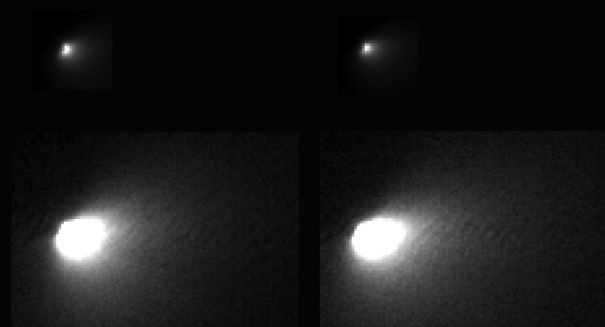
Despite a close brush with Mars, the ancient comet Siding Spring managed to miss all five orbiters and the Red Planet.
On Sunday, all five Mars orbiters gave scientists a close-up view of Comet C/2013 A1, nicknamed “Siding Spring.” The data sent back by these orbiters will give researchers a valuable firsthand glimpse at the ancient comet.
Siding Spring, originating from the distant Oort cloud, was originally predicted to hit Mars. Luckily, the Red Planet and its five orbiters were all safe after the comet’s historic passing. Siding Spring missed Mars by 87,000 miles, considered a close encounter in cosmic terms.
A variety of crafts were able to gather data from the comet’s passing. NASA’s Mars Reconnaissance Orbiter took high-resolution pictures of Siding Spring from a telescopic camera. These are the first images of a long-period comet entering the inner solar system.
Managed by the University of Arizona, MRO’s HiRise camera snapped pictures from a relatively close distance away at 86,000 miles. These photographs allowed scientists to determine that Siding Spring’s nucleus was much smaller than originally thought, with a width of only half a kilometer.
In addition to its size, MRO’s camera also noted the brightness and composition of the comet. The camera’s view and aim were directed by Lockheed Martin engineers in Denver, CO.
After floating in the faraway Oort Cloud for billions of years, Siding Spring just made its first pass by the sun. The comet is a remnant from the early solar system’s formation.
According to astrophysicist Carey Lisse of the Johns Hopkins University Applied Physics Laboratory, “The comet was placed there after it formed, we think, in the first million or few million years of the beginnings of our solar system, so it’s a body that’s older than the Earth. Imagine a body that’s about the size of a small Appalachian mountain or Downtown D.C. It’s made roughly half of rocky dust and half of volatile ices like water, carbon dioxide and carbon monoxide.”
The pictures sent back by the orbiters’ cameras will shed additional light on the formation of the early solar system as evidenced in pictures of Siding Spring.
Leave a Reply